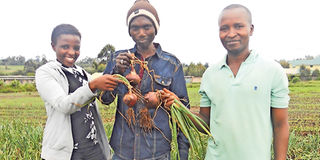For a perfect bulb onion, planting depth is crucial

Lucy Wangari with workers on her onion farm in Kiambu County. Onions are usually ready for harvest in three to four months after transplanting. PHOTO | FILE | NATION MEDIA GROUP
What you need to know:
- With very small-bulb onions, one needs up to 30 of them to make a kilo. Normally, six to eight medium-sized bulb onions make a kilo.
- Minimum tillage should be avoided in black cotton soil as ploughing the land ensures proper soil aeration. Also, incorporate well-rotten manure into the soil before planting.
- Acquire seeds that are adapted to the ecological conditions of your location and ensure they are resistant to pests and diseases.
- Seedlings planted too closely together normally result in the formation of small bulb onions, while too much spacing may also result in the formation of very big bulb onions.
Onion is one of the most-prized crops because growers can make a fortune from them if they time the planting well.
The price of the produce has significantly risen due to the onset of the rains, with a kilo going for as high as Sh150 in Mombasa, Sh80 in Kajiado and Sh100 in Nairobi.
However, one of the challenges farmers growing the crop face is ending up with small bulbs.
Eric, who grows onions on a quarter of an acre, recently told me that he harvested bulbs that were so small that he was embarrassed about being called a farmer.
He had expected to harvest up to four tonnes but ended up with 500kg, causing him losses.
From the pictures and videos he sent me, I could see that the bulbs were too small while some plants appeared dried.
With very small-bulb onions, one needs up to 30 of them to make a kilo. Normally, six to eight medium-sized bulb onions make a kilo.
On a separate block, the onions appeared like they were ready for harvesting, because the leaves had already dried.
I asked him to uproot a few plants and send me the video. I could notice the crops were deeply planted, unlike the recommended shallow planting depth of about 1-1.5 inches.
The soil also had a lot of compaction and one could easily see the cracks on the surface. This usually happens in dry soils, for instance, the black cotton soils that form hard pans, hindering bulb expansion.
Minimum tillage should be avoided in black cotton soil as ploughing the land ensures proper soil aeration. Also, incorporate well-rotten manure into the soil before planting.
This helps in improving the soil structure and hence reduces the formation of hard pans that affect the bulb expansion.
One should also ensure that the land is well-levelled before planting as this ensures uniform growth and prevents waterlogging on sections of the farm.
DRAINAGE CHANNELS
Drainage channels should be well done to ensure proper flow of water. It also helps when one makes raised beds of about 15-20cm to encourage drainage.
Acquire seeds that are adapted to the ecological conditions of your location and ensure they are resistant to pests and diseases.
Transplanting should be done after 4-5 weeks of sowing seeds in the nursery bed.
Transplant the seedlings at the same depth as they were in the nursery bed. The depth of planting should be about 1-1.5 inches.
Plant population and fertiliser regime are critical in determining the size, weight and general quality of onions produced.
Seedlings planted too closely together normally result in the formation of small bulb onions, while too much spacing may also result in the formation of very big bulb onions.
The ideal spacing should be 5cm by 8cm or 10cm by 15cm, depending on the variety and the required onion size.
Plant a single seedling per hole as two or more reduce yields. Apply the fertiliser as close as possible to the root zone in splits and in readily available forms since the bulb onions are shallow-rooted with thick roots and very short hairs.
It’s vital to apply a fertiliser that supplies balanced nutrients both macro and micro nutrients to increase the bulb size.
While planting, apply phosphorus fertilisers such as DAP as this will help in root development.
Nitrogen should be applied to encourage the vegetative growth as each leaf the onion puts out is a ring on the bulb, this means the more the leaves, the bigger the onion.
Potassium should be applied to help in bulb formation. The fertilisers should be applied in splits to ensure maximum utilisation by the plant. One should ensure the soil is moist especially during the early stages of growth.
Also, it’s vital to prevent fungal diseases like downey mildew that affect the leaves and causes them to dry off before the bulb is well formed.
Be on the lookout to prevent attacks from thrips as the injuries caused create entry points for pathogens and make the plant more susceptible to fungal infection.
Onions are usually ready in three to four months after transplanting. Ensure the leaves are fully dried before harvesting to increase their shelf life.





